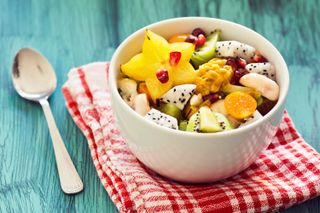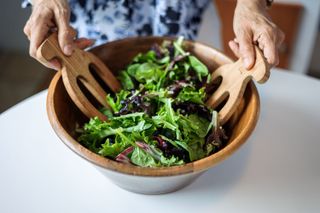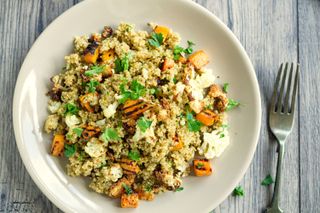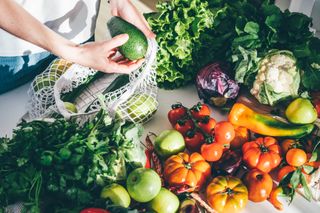7 day detox plan to kick-start your metabolism and help you lose weight
We've asked the experts to help us put together this week-long detox plan so you can reach your weight loss goals safely


Seven-day detox plans come in many different shapes and sizes, from simply upping your water intake to strict regimes like the keto diet. But are detoxes just a fad? We've asked the experts.
Over the years, celebrities and influencers have turned seven-day detox plans into one of the 'quick fix' diets that works fast to lose weight. While popular weight loss options like intermittent fasting and diets such as the 5:2 and 16:8, for example, require timed eating and calorie counting, detox plans are short-term and often include a strict diet of fruit, vegetables, juices, and water. The idea is that doing a detox diet eliminates 'toxins' from your body, but the truth is that your body is capable of detoxing itself without changing your diet, and if you had really accumulated a build of toxins, you'd feel extremely ill.
As nutritionist Kim Pearson explains: "A lot of people refer to detoxing in the same way as crash dieting. A week-long detox or cleanse will not magically reverse weeks, months or even years of unhealthy living. If we are healthy, our body’s detoxification systems act efficiently and carry out their jobs day to day, whether we are 'detoxing' or not." With that being said, there are some aspects of cleansing that have health benefits, as long as you continue to consume a balanced diet with an adequate amount of calories and protein. If you're considering trying a seven-day detox plan, it's important you understand how they work and how to follow them properly.
What is the 7 day detox plan?
A seven-day detox plan is essentially a 'clean eating programme' that involves eating significantly more fresh fruits and vegetables and drinking plenty of herbal tea and water for seven days. The idea is that the detox diet will 'cleanse' the body of harmful toxins.
These toxins can be both environmental and part of your diet. Nutritional advisor at Bio Kult, Claire Barnes, explains: "We are constantly bombarded with environmental toxins; paint and cleaning chemicals in the home, radiation from Wi-Fi, traffic pollution and pesticides from fields, to name but a few."
A post shared by The Fabulous App (@thefabstory)
A photo posted by on
"Toxins may also enter the body through our consumption of artificial sweeteners, food additives, alcohol, smoking, medications and even the chemicals we rub into our skin and hair. Not only are our body’s battling with toxins entering the body from the outside world, but we also naturally produce our own toxins, such as urea, carbon dioxide and lactic acid which must be excreted from the body."
To limit your alcohol intake, why not try one of the best non-alcoholic wines instead?
GoodtoKnow Newsletter
Parenting advice, hot topics, best buys and family finance tips delivered straight to your inbox.
Claire goes on to say, "In addition to these, some less desirable bacteria that may live in our digestive tract can also produce toxins that could cross the intestinal lining and enter the bloodstream."
This is where the seven-day detox plan comes in, as it promises to promote the elimination of toxins. However, there is very little scientific evidence that suggests detox diets actually work, and your body is capable of cleansing itself through the liver, faeces, urine, and sweat.
For example, one study in the Archives of Environmental Contamination and Toxicology found that sweating appears to be a potential method for the elimination of many toxic elements from the human body.
How does the 7 day detox plan work?
There are three phases of natural detoxification in the body.
- Phase 1: Enzymes protect cells from damage by breaking the toxins down into smaller, water-soluble substances.
- Phase 2: Substances from phase one bind with other substances, known as conjugates, to make them less harmful and even more soluble for excretion.
- Phase 3: Waste removal into the kidneys to be excreted in the urine or into the liver to be excreted through bile into the digestive tract and excreted via stools.
Kim goes on to explain that there are two main ways you can support your body’s natural detoxification processes".
"Firstly, ensure you are getting enough dietary fibre which supports healthy elimination of waste from the bowel. If we have a low-fibre diet and aren’t having regular bowel movements then our body may reabsorb the filtered toxins. Eating a wide range of organic vegetables is a great way to increase your fibre intake."
Following a high-fibre diet outside of the detox can also help with this when the plan is over.
"Secondly, drink plenty of water which supports the elimination of waste via the kidneys."
A study in Alternative Therapies in Health and Medicine found that by introducing a variety of foods supplying key nutrients can maximize the effectiveness of the body's natural detoxification process.
However, if you are still keen to give a detox plan a go, below is some information to help get you started.
What can you eat as part of a 7 day detox plan?
- High quantities of vegetables: These are essential, as they will ensure that there's plenty of fibre, vitamins C and E, magnesium, zinc in your diet.
- Eggs, raw garlic, onions, leeks and shallots: These foods all contain natural sulphur compounds that help with phase two of the detoxification process.
- Lentils and chickpeas: Both are highly nutritious, as they contain plenty of protein which is essential for phase one of the detox. They're also high in fibre and antioxidants, both essential for all phases of the detoxification process.
- Fish: In particular salmon, is very low in fat and high in protein, and high in B vitamins, selenium and antioxidants - all of which are essential in phase one.
- Wholemeal bread: They'll not only keep you feeling full and so more likely to stick to the detox, but wholemeal grains are packed with fibre and B vitamins, iron, magnesium and selenium.
Our 7 day detox plan:
Day 1
Breakfast
- 1 portion fresh fruit (vary throughout the week between apple, pear, mango, grapes, pineapple, grapefruit)
- 2 slices of wholemeal toast, with low fat cottage cheese
- A carton of low-fat live yoghurt
- Small glass of skimmed milk
- Cup of herbal tea or water

Lunch
- 1 kiwi fruit
- Mixed raw vegetable salad (a bed of iceberg lettuce, filled with grated carrot, celeriac and beetroot, with a squeeze of lemon juice and a drizzle of olive oil)
- Steamed vegetables, sprinkled with a chopped clove of garlic and a drizzle of olive oil
- Herbal tea or water
Dinner
- Omelette with steamed vegetables (eg. broccoli, cabbage, brussels sprouts, cauliflower)
- Water
Day 2
Breakfast
- Green smoothie (including kiwi, spinach, grapes, watercress, milled mixed seeds and low-fat natural bio yoghurt)
Lunch
- 1 large mango
- Mixed salad including watercress, fresh mint, spring onions, tomato, red and yellow peppers, chicory, baby spinach and beansprouts drizzled with a lemon juice and olive oil dressing
- 1 large jacket potato with low-fat fromage frais whipped with chopped chives and a clove of garlic
- Vegetable juice or water

Dinner
- Vegetable stew (with onions and raw garlic)
- Water
Day 3
Breakfast
- As on day 1 or 2
Lunch
- Lentil and chickpea soup
- Herbal tea or water
Dinner
- Cooked brown rice with steamed vegetables (including celery, leek, carrot, tomato, spinach, broccoli and shredded cabbage)
- Herbal tea or water

Day 4
Breakfast
- As on day 1 or 2
Lunch
- 1 apple and 1 pear
- Raw vegetable salad (cauliflower and broccoli florets, carrot, spring onion, grated red cabbage, mange tout) tossed in olive oil and cider vinegar dressing, sprinkled with a teaspoon of raisins and 3 chopped brazil nuts
- Large jacket potato filled with 75g (3oz) steamed spinach chopped with 2 teaspoons of olive oil, clove of garlic and a generous grating of nutmeg
- Herbal tea or water
Dinner
- Baked salmon with a side of spinach
- Herbal tea or water

(If you're vegetarian or don't like fish, stir-fry tofu with shredded carrot, bean sprouts, mange tout and soy sauce or have a grilled veggie burger).
Day 5
Breakfast
- As on day 1 or 2
Lunch
- 1 banana
- Mixed salad (shredded iceberg lettuce tomato, olives, red pepper, carrot, spring onions, cucumber, a clove of garlic, fennel and watercress) with a dressing of lemon juice, walnut oil and tarragon
- 1 large jacket potato with steamed French or runner beans with a dessertspoon of sunflower oil sprinkled with finely chopped onions
- Herbal tea or water

Dinner
- 1 pink grapefruit
- 2 poached free-range eggs
- 2 slices of wholemeal toast with a scrape of butter
- Herbal tea or water
Day 6
Breakfast
- Same as day 1 or 2
Lunch
- Mixed salad (watercress, baby spinach, mixed lettuce leaves, parsley, celery, garlic, chives, basil, tomato - with a dressing of 1/3 walnut oil, 1/3 olive oil, 1/3 cider vinegar and a teaspoon of Dijon mustard, sprinkled with sunflower seeds)
- 75g (3oz) boiled potatoes and trout stuffed with finely chopped parsley, onion, tomato and pine nuts, covered in thinly sliced lemon, baked in foil with a little olive oil.
Dinner
- Lentil and vegetable salad (include: butternut squash, red pepper and broccoli florets, 2tbsp cooked brown rice) with a dressing made by combining 1tbsp sesame oil, 1tsp fresh chopped ginger, 1tsp seame seeds and 1tsp light low-salt soya sauce.
- Herbal tea or water
Day 7
Breakfast
- Same as day 1 or 2
Lunch
- Cucumber and prawn stir fry (or with avocado if vegetarian)
- Water or herbal tea
Dinner
- Quinoa and butternut squash salad
- Herbal tea or water

Is the 7 day detox plan good for weight loss?
Most people can lose weight on a detox programme, but the amount of weight you can lose will vary depending on the degree of calorie restriction. This is because to lose any weight (and keep it off), you have to be in a calorie deficit - essentially you need to be consuming fewer calories than the number of calories you burn a day.
However, many fitness experts don't recommend a detox diet as a safe and effective way to lose weight. They say that detoxing solely for weight loss is unsustainable - even in the short term - and the negatives tend to outweigh the positives.
"Juicing or detoxification diets may seem to work because they lead to extremely low caloric intake, however they tend to lead to weight gain once a normal diet is resumed." Daniel Carpenter, personal trainer at Common Purpose Club, says. "In terms of weight loss, at best detoxification plans and products are a waste of time and money, at worst they may be harmful depending on how extreme the protocol is."
Generally, opting for a calorie deficit through sensible calorie consumption and increased exercise is a better way to go. The NHS recommends a daily calorie intake of 2,000 calories a day for women and 2,500 for men, and typically to lose weight you have to eat 500 calories less than your maintenance level.
If you have a calorie deficit of 500 per day you’ll lose one pound per week, according to a study published in The American Journal of Clinical Nutrition.

Advice on detoxing from the nutritionists
1. Start with small steps
Dr Simone Laubscher, founder of Rejuv Wellness, recommends starting at the beginning, rather than delving straight into an intensive detox.
"The key is to be wise; start off swapping your breakfast for a green juice and see how you feel. Then, day-by-day, cut sugar, then coffee etc. Wellness is a journey, so go at your own pace and don't forget to drink 2-3L of water each day, for this will make your detox journey much easier."
She adds, "It’s far better to take good care of your body each week and do a seasonal cleanse, than to do an annual post-New Year crash detox for example."
2. Don't buy into the 'detox' label without doing your homework
"Detox teas and supplements are unlikely to be significantly useful on their own, and often have little or no research to back their effectiveness," Kim Pearson says.
"Avoid juice cleanses based on fruit juice. You will likely end up consuming a large amount of fructose (fruit sugar) which is not supportive of liver health. It's important to do your research and make sure you are not likely to undertake any kind of diet or detox programme that could cause more harm than good."
3. Make sure that your organs are in good health
Claire reminds us that the theory behind detoxing is to "release any toxic build up in our body cells", so "before commencing a detox plan, it is imperative to ensure that all the detoxification organs are capable of effectively coping with the released toxins."
She says,"Healing the gut should be prioritised as a leaky gut could lead to the released toxins being reabsorbed into the body. A slow bowel transit can also mean that toxins are held in the body for longer, increasing the chance of them being reabsorbed.
Improving gut health has been a major focus of the wellness industry over the last couple of years, with everything from weight loss to our stress levels impacted by it.

Grace Walsh is a health and wellbeing writer, working across the subjects of family, relationships, and LGBT topics, as well as sleep and mental health. A digital journalist with over six years experience as a writer and editor for UK publications, Grace is currently Health Editor for womanandhome.com and has also worked with Cosmopolitan, Red, The i Paper, GoodtoKnow, and more. After graduating from the University of Warwick, she started her career writing about the complexities of sex and relationships, before combining personal hobbies with professional and writing about fitness.
-
 New research shows number of children taking sleeping pills has doubled over past 7 years - but there are other ways to help children build better sleep habits
New research shows number of children taking sleeping pills has doubled over past 7 years - but there are other ways to help children build better sleep habitsA number of lifestyle factors have made sleeping more difficult for children in recent years, experts say
By Charlie Elizabeth Culverhouse Published
-
 Eva Mendes opens up about ‘no-brainer’ parenting agreement with Ryan Gosling after her words were ‘taken out of context’ in recent interview
Eva Mendes opens up about ‘no-brainer’ parenting agreement with Ryan Gosling after her words were ‘taken out of context’ in recent interviewThe actress has spoken out after her words were 'taken out of context'
By Charlie Elizabeth Culverhouse Published